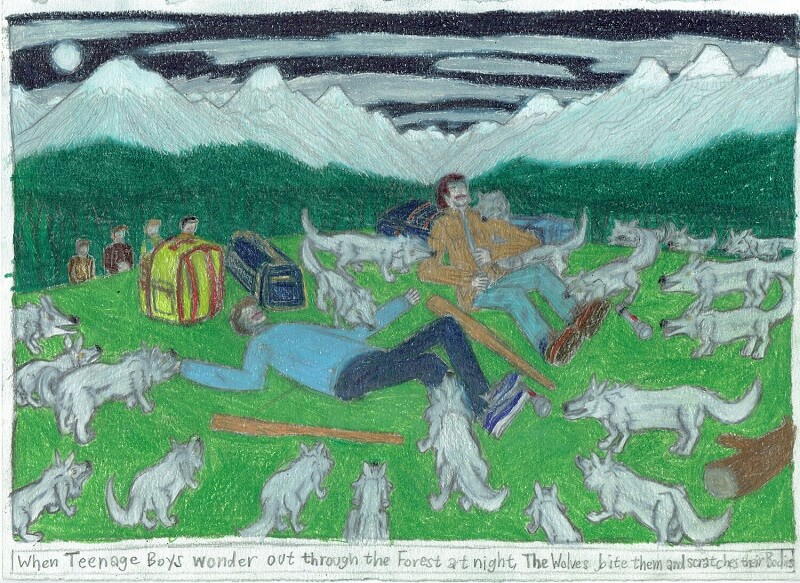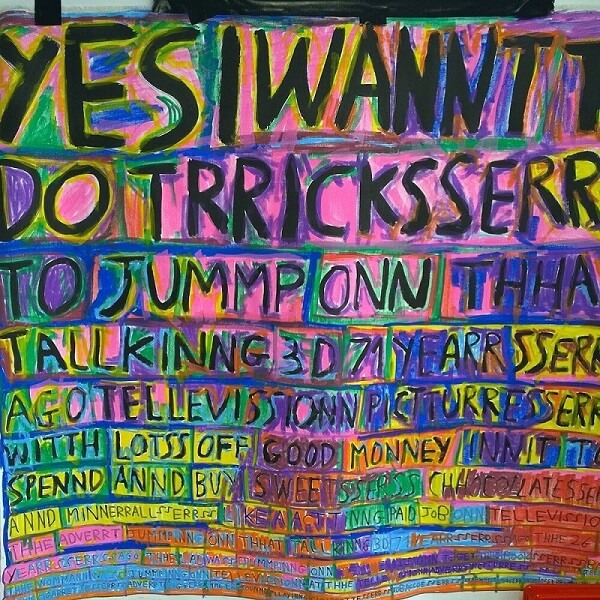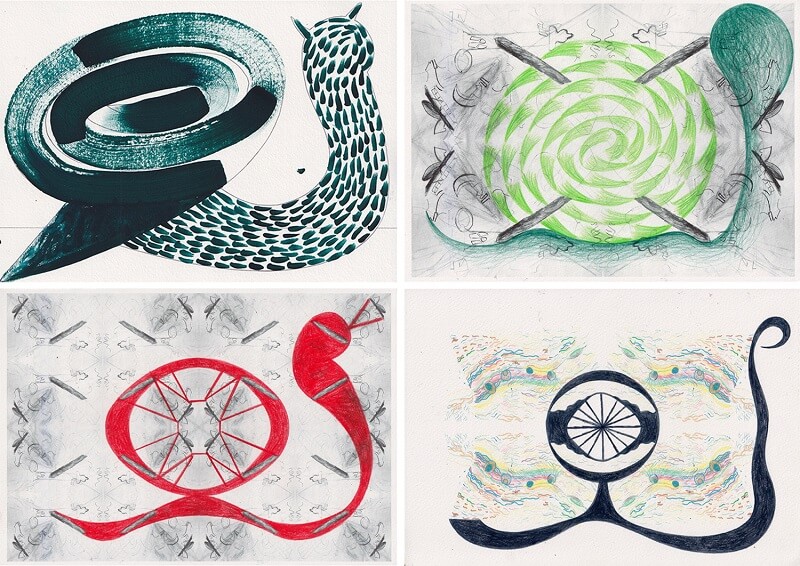Art et al. is a new curatorial arts platform, which was established in 2020 through the motivations of a partnership between co-founders, Sim Luttin, Arts Project Australia (APA), UK-based Lisa Slominski, Slominski Projects and Jennifer Gilbert, Jennifer Lauren Gallery, and the Australia Council for the Arts, with the view to showcase the extraordinary creative output and quality of work being made by neurodiverse artists from Australia, the United Kingdom and further abroad, while also giving rise to the valuable contributions these artists make to the global arts and cultural landscape.

Prompted by their shared vision to support, develop and promote the artistic practices of neurodiverse and intellectually or learning-disabled artists, Art et al. founding members Luttin, Slominski and Gilbert, have taken a synergistic approach to bringing artists and their peers, supported studios and arts professionals, together across international borders to produce and exhibit collaborative works, while also making them accessible to wider reaching audiences via the innovations of the digital platform, as well as physical exhibits when possible.
Luttin is the curator and manager of Melbourne’s APA Gallery. In the interview below Luttin talks about Arts Project Australia’s involvement in helping to advance the careers of artists living and working with intellectual disability since 1974, and her outlook as curator. Luttin follows with insightful discussion about the emergence of Art et al., how the program will inspire unique explorations between artists and industry collaborators, and also reveals how the organisation plans to expand the program for participants and audiences in the future.
How has Arts Project Australia, impacted on the development, recognition and presentation of artists and their work, from its beginning to now?
As an agile social enterprise, Arts Project Australia (APA) has continually pushed itself to lead the field regarding its advocacy and promotion of artists with intellectual disability in Australia and worldwide. There is no doubt that APA’s studio model — based on non-interventionist, peer to peer artist support — has been key to the success, recognition and reputation of its artists and the organisation more broadly. With an almost 50-year history, APA is well-known for professionally supporting individual artists to reach their creative potential.
Looking at the big picture what is your vision as manager and curator of APA Gallery and the representation of its artists?
As a long-time, arts professional, I am passionate about supporting neurodiverse artists to be seen, represented, and connected in contemporary art and culture sectors. My vision is to grow key opportunities for APA’s artists to experiment, collaborate, exhibit and gain recognition for their invaluable and distinctive contribution to arts and culture in Australia, as well as internationally. APA can foster this recognition first and foremost by engendering innovative, open and inclusive programming in partnership with other aspirational creatives, producers and industry leaders. By engaging exceptional artists, writers and curators to work with APA and its artists, the organisation can attract industry partners who align with the APA’s vision and values, in turn empowering artists, increasing their visibility, and enabling individuals to achieve great things.

How did Art et al. transpire and in what ways does it strive to support the creative practices and careers of neurodiverse and intellectually or learning-disabled artists?
We identified a need for more inclusive programming and access in contemporary art for neurodivergent, intellectually and learning-disabled artists to be seen, heard and participate. Our motivation came from our years working within the sector, seeing how slow the progress was and often becoming frustrated with how organisations presented these artists’ works. As a result, we formed Art et al. – an international platform connecting artists from supported studios with global peers, arts professionals, and audiences.
By supported studio, we mean a creative environment for individuals with specific health or social needs that encourages and supports the different art practices of artists. Our global collaborations and partnerships result in commissioned critical writing, exhibitions and original multi-media content presented online through our website and in-person at accessible events when allowed.
What is APA’s role as part of this project?
While we had the opportunity to pitch a project that would solely promote our artists in the UK, we decided instead to partner with Jennifer Lauren Gallery and Slominski Projects to widely promote Australian and UK artists identifying as neurodivergent, intellectually and learning disabled. Soon after, with the encouragement of leaders in the sector, we embarked on building a new international platform, with relevance, inclusivity, respect, accessibility, collaboration and innovation at the forefront of our minds.
Regarding Art et al.’s artist commissions designed for international collaborations, what are the possible benefits and opportunities for artists working together in this way?
It is an exciting time to be developing an aspirational and inclusive international curatorial platform. We are looking at how our commissioned projects can be most impactful in raising the visibility and profile of the artists we’re working with within global contemporary arts. Through our projects, we know Art et al. will open doors for artists whilst changing the industry regarding what is programmed, where, and how people can access it. By creating paid opportunities to facilitate meaningful and respectful international collaborations, Art et al. is already redefining modes of working and engaging creatively on ambitious projects with neurodiverse artists.
Essentially, we redefine outdated arts paradigms by saying “anything is possible”. As long as the appropriate framework, professional support and timeframes are put in place and made broadly available, including sourcing appropriate expertise, ethical partners, funding, and accessible technology.
How are commissioned works developed between artists and how are they presented to audiences? Presently, artists are invited to partner or collaborate on a project: I am in Australia, whilst Lisa and Jennifer are in the UK. All three of us have connections across our countries, and within supported studios and galleries worldwide. We take the lead on the most relevant things based on our backgrounds and skills. For example, Lisa has worked closely with the Cranford Collection for many years — a significant private collection of contemporary Art — so she liaised with them on our first Curating Collections collaboration. Their collection curator, Anne Pontégnie, worked closely with Arts Project Australia artist Michael Camakaris, with the outcome ‘Antidote’ published on our website.
You will also find things presented in accessible formats on our website, including a YouAccess widget allowing visitors to customise font size, colour and link highlights, downloadable Easy Reads, BSL interpretation, audio translations, flip books, video captioning, and FAQs to assist in explaining language that may be difficult to understand.


“Working with David has been a real privilege and pleasure. Apart from admiring his beautiful work, our weekly conversations (via zoom) have been the most interesting aspect of the collaboration. David’s spontaneity of ideas and fascinating ability to make correlations between initially seemingly disparate elements has been fundamental to my own approach and thinking when engaging in making for this project.” – Alasdair McLuckie, Australia-based artist and Art et al. contributor, May 2021
Tell us about the #MondayMuse project? How can artists get involved and audiences follow?
The Art et al. team wanted to ensure that outside of invitational opportunities we could enable pathways for artists identifying with a disability to engage with us directly, and for artists — even those relatively unknown — to be exposed to a broader audience. Artists can submit to #MondayMuse several ways, including via the form on our website, downloading our editable PDF, or if accessibility is an issue contacting us, or having someone contact us by email or phone.
As well as the development and presentation of visual art-based works, what other forms of creative expression does Art et al. want to support and exhibit?
We plan to grow Art et al. and its content in the UK and Australia, raising awareness of the platform and the artists featured. Our vision includes stepping out into Europe and America in 2022 with opportunities for further collaborative exhibitions, writing, events and partnerships. There are also plans in the pipeline to create a series of podcasts and artist and project videos. However, this type of content production is time-consuming and expensive to do well, and achieving these goals is dependent on us attracting significant long-term funding and investment.
Art et al. notes a commitment to ‘create an open, diverse, and inclusive contemporary art world’. How can local audiences and the wider reaching global arts community actively participate, and help the initiative gain momentum?
It is an exciting time to be developing this aspirational platform and looking at how we can use it. We want to increase sector knowledge of the artists we are working with, and we want to change the sector in terms of what we program, how we program it, and who can actively participate in contemporary arts. Our current focus is on creating content, audiences and a sustainable business model. We are developing multiple access points for artists and audiences to engage, including through our website and social media, and in-person programming when travel permits.
We want people to engage with the content at this early stage – to read, view, and explore the platform. Future thinking, we are exploring other interactive possibilities, where local and global audiences will engage directly with the team and invited artists through online and in-person discussions, exhibitions and events.
Visit Art et al’s digital art platform here to explore newly released works, interviews, studio spotlights, essays and more as it unfolds.